H&S MS125 Operating instructions
- Category
- Spreader
- Type
- Operating instructions

Manufactured By
H&S MANUFACTURING CO.,INC.
P.O. BOX 768 (715) 387-3414 FAX (715) 384-5463
MARSHFIELD, WISCONSIN 54449
WARNING
125 PT125 PT
125 PT125 PT
125 PTOO
OO
O
MANURE SPREADERMANURE SPREADER
MANURE SPREADERMANURE SPREADER
MANURE SPREADER
OPERAOPERA
OPERAOPERA
OPERATT
TT
TOR’S MANUOR’S MANU
OR’S MANUOR’S MANU
OR’S MANUALAL
ALAL
AL
Revision #01
Starting Serial #511550 HSMFG1014 Part #64237
READ AND UNDERSTAND THIS MANUAL
BEFORE OPERATING THIS EQUIPMENT.
UNSAFE OPERATION OR MAINTENANCE OF
THIS EQUIPMENT CAN RESULT IN SERIOUS
INJURY OR DEATH.

CONTENTS
Warranty . . . . . . . . . . . . . . . . . . . . . . . . . . . . . . . . . . . . . . . . . . . . . . . . . . . . . . . . . . . . . . . . . . . . . . . . . 1-2
Manufacturer’s Statement . . . . . . . . . . . . . . . . . . . . . . . . . . . . . . . . . . . . . . . . . . . . . . . . . . . . . . . . . . . . . 2
Pre-Delivery Checklist . . . . . . . . . . . . . . . . . . . . . . . . . . . . . . . . . . . . . . . . . . . . . . . . . . . . . . . . . . . . . . 3-4
Delivery Checklist . . . . . . . . . . . . . . . . . . . . . . . . . . . . . . . . . . . . . . . . . . . . . . . . . . . . . . . . . . . . . . . . . 5-6
Safety Information - Be Alert Symbol . . . . . . . . . . . . . . . . . . . . . . . . . . . . . . . . . . . . . . . . . . . . . . . . . . . 7
Safety Information - Explanation of Safety Signs . . . . . . . . . . . . . . . . . . . . . . . . . . . . . . . . . . . . . . . . . . . 8
Safety Decals . . . . . . . . . . . . . . . . . . . . . . . . . . . . . . . . . . . . . . . . . . . . . . . . . . . . . . . . . . . . . . . . . . . . 9-10
Safety Information - Warning - Owner Must Read and Understand . . . . . . . . . . . . . . . . . . . . . . . . . . . 11
Cap Screw Torque Values . . . . . . . . . . . . . . . . . . . . . . . . . . . . . . . . . . . . . . . . . . . . . . . . . . . . . . . . . . . . 12
Set - Up & Assembly . . . . . . . . . . . . . . . . . . . . . . . . . . . . . . . . . . . . . . . . . . . . . . . . . . . . . . . . . . . . . . . . . 13
Transporting . . . . . . . . . . . . . . . . . . . . . . . . . . . . . . . . . . . . . . . . . . . . . . . . . . . . . . . . . . . . . . . . . . . . . . . . 13
Preparing for Opertation. . . . . . . . . . . . . . . . . . . . . . . . . . . . . . . . . . . . . . . . . . . . . . . . . . . . . . . . . . . . . . . 14
Operation . . . . . . . . . . . . . . . . . . . . . . . . . . . . . . . . . . . . . . . . . . . . . . . . . . . . . . . . . . . . . . . . . . . . . . . . . . 15
Adjustments . . . . . . . . . . . . . . . . . . . . . . . . . . . . . . . . . . . . . . . . . . . . . . . . . . . . . . . . . . . . . . . . . . . . . . . . 16
Service . . . . . . . . . . . . . . . . . . . . . . . . . . . . . . . . . . . . . . . . . . . . . . . . . . . . . . . . . . . . . . . . . . . . . . . . . 17-18
Optional Equipment . . . . . . . . . . . . . . . . . . . . . . . . . . . . . . . . . . . . . . . . . . . . . . . . . . . . . . . . . . . . . . . . . . 19
Lubrication Guide . . . . . . . . . . . . . . . . . . . . . . . . . . . . . . . . . . . . . . . . . . . . . . . . . . . . . . . . . . . . . . . . 20-21
Decal Location . . . . . . . . . . . . . . . . . . . . . . . . . . . . . . . . . . . . . . . . . . . . . . . . . . . . . . . . . . . . . . . . . . . 22-24
Trouble Shooting . . . . . . . . . . . . . . . . . . . . . . . . . . . . . . . . . . . . . . . . . . . . . . . . . . . . . . . . . . . . . . . . . . . . 25
Service Notes . . . . . . . . . . . . . . . . . . . . . . . . . . . . . . . . . . . . . . . . . . . . . . . . . . . . . . . . . . . . . . . . . . . . . . . 26
Specifications . . . . . . . . . . . . . . . . . . . . . . . . . . . . . . . . . . . . . . . . . . . . . . . . . . . . . . . . . . . . . Inside Back Cover



-3-
Manure spreader was not damaged in shipment. Check for dents and loose or missing
parts. Report damage immediately to H&S Manufacturing Co., Inc.
All bolts and fasteners are tight.
Manure spreader has been correctly assembled according to instructions in this manual.
All grease fittings have been lubricated. Gearbox is filled to proper level.
Guards and shields are secure.
Wheels are properly mounted to torque specifications.
Tires are inflated to correct pressure.
Drive chain tension and alignment is correct.
Decals are in place and legible.
Main apron chains are adjusted properly.
DEALER PRE-DELIVERY CHECK LIST
AFTER COMPLETION, DEALER SHOULD REMOVE AND RETAIN FOR RECORDS
After the Manure Spreader has been completely set-up, check to be certain it is in correct operating
order before delivering to the customer. The following is a list of points to inspect. Check off each
item as you have made the proper adjustments and found the item operating satisfactorily.
Connect the manure spreader to a proper horsepower tractor and attach the PTO. Run the
manure spreader and make sure all components operate properly.
PTO guard turns freely.
Main apron operates smoothly.
Implement and all components are functioning properly.
(Remove Dealer File Copy At Perforation)
Serial #
Dealer’s Name
Signature of Pre-Delivery Inspector
Inspection Date
Model Number

Intentionally Left Blank
-4-

-5-
This check list that follows is an important reminder of valuable information that should be passed
on to the customer at the time this Manure Spreader is delivered.
Check off each item as you explain it to the customer.
This delivery check list, when properly filled out and signed assures the customer that the
Pre-delivery service was satisfactorily performed.
Explain to the customer that the pre-delivery inspection was made.
Explain to the customer all the safety precautions they must excercise when operating
this unit.
Explain recommended loads for different types of materials.
Explain to customer that regular lubrication is required for proper operation and long life of
machine.
Show customer the lubrication section of Owner’s Manual.
Give the customer Owner’s Manual and make sure they read and understand all operating
and service instructions.
Have the customer sign a completed “Warranty Registration”, and mail it.
DEALER DELIVERY CHECK LIST
(Remove Dealer File Copy At Perforation)
AFTER COMPLETION, DEALER SHOULD REMOVE AND RETAIN FOR RECORDS
Date Delivered
Dealer’s Name
By
Signature of Original Buyer
Note: Warranty is not valid until warranty card is completed and returned to H&S Mfg. Co., Inc.

Intentionally Left Blank
-6-

YOUR SAFETY
IS INVOLVED.
-7-
BE
ALERT!
THIS SYMBOL IS USED THROUGHOUT THIS BOOK WHENEVER YOUR PERSONAL SAFETY
IS INVOLVED. TAKE TIME TO BE CAREFUL. REMEMBER: THE CAREFUL OPERATOR IS THE
BEST OPERATOR. MOST ACCIDENTS ARE CAUSED BY HUMAN ERROR. CERTAIN
PRECAUTIONS MUST BE OBSERVED TO PREVENT THE POSSIBILITY OF INJURY OR
DAMAGE.
SAFETY INFORMATION
H&S MANUFACTURING CO., INC.

-8-
RECOGNIZE SAFETY INFORMATION
This is the safety-alert symbol. When you see this
symbol on your machine or in this manual, be alert to
the potential for personal injury.
Follow recommended precautions and safe operating
practices.
UNDERSTAND SIGNAL WORDS
A signal word; DANGER, WARNING, or CAUTION - is
used with the safety-alert symbol. DANGER identifies the
most serious hazards.
Safety signs with signal word DANGER or WARNING are
typically near specific hazards.
General precautions are listed on CAUTION safety signs.
FOLLOW SAFETY INSTRUCTIONS
Carefully read all safety messages in this manual, and all safety signs on your machine. Follow all
recommended precautions and safe operating procedures.
SAFETY INFORMATION
OBSERVE MAXIMUM TRANSPORT SPEED
The maximum transport speed for this implement is 32 km/h (20 m.p.h.).
Some tractors are capable of operating at speeds that exceed the maximum
transport speed of this implement. Regardless of the maximum speed capability
of the tractor being used to tow this implement, do not exceed the implement’s
maximum transport speed.
Exceeding the implements maximum transport speed can result in:
* Loss of control of the tractor/implement combination
* Reduced or no ability to stop during braking
* Implement tire failure
* Damage to the implement structure or its components
Use additional caution and reduce speed when towing under adverse surface
conditions, when turning, and when on inclines.
Do not attempt transport if the fully loaded implement weighs more than 1.5 times
the weight of the tractor.
Keep signs in good condition. Immediately replace any missing or damaged signs.

SAFETY INFORMATION
-9-

SAFETY INFORMATION
-10-

-11-
TO PREVENT SERIOUS INJURY OR DEATH
Study The Above Safety Rules
ATTENTION - BE ALERT - YOUR SAFETY IS INVOLVED
BEFORE YOU ATTEMPT TO OPERATE THIS EQUIPMENT, READ AND STUDY THE FOLLOWING
INFORMATION. IN ADDITION, MAKE SURE THAT EVERY INDIVIDUAL WHO OPERATES OR WORKS
WITH THIS EQUIPMENT, WHETHER FAMILY MEMBER OR EMPLOYEE, IS FAMILIAR WITH THESE
SAFETY PRECAUTIONS.
KNOW HOW TO STOP UNLOADING MECHANISM BEFORE STARTING IT.
If the machine becomes clogged, disengage the PTO. Stop the tractor engine, remove ignition key, and
allow all mechanisms to stop before cleaning or working on the machine.
DO NOT get off the tractor while the spreader is in operation.
DO NOT attempt to perform maintenance or repair with tractor running and PTO engaged.
DO NOT step up on machine at any time.
NEVER manually feed material into the beaters.
DO NOT allow minors to operate or be near the machine.
DO NOT ALLOW PERSONNEL OTHER THAN THE QUALIFIED OPERATOR NEAR THE MACHINE.
Before starting tractor, be sure PTO shields turn freely and PTO is securely locked to tractor.
DO NOT clean, adjust, or lubricate the machine when any part is in operation.
Keep hands, feet, and clothing away from beaters when they are revolving.
Loose or floppy clothing should not be worn by the operator.
Be sure the machine is clear of people, tools, and other objects before engaging PTO.
DO NOT step over power take off shaft. Stay clear of PTO at all times.
NEVER start manure spreader until all guards and safety shields are secured in place.
H&S always takes the operator and their safety into consideration and guards exposed moving parts
for their protection. However, some areas cannot be guarded or shielded in order to assure proper operation.
In addition, the operators manual and decals on the machine itself warn you of further danger and should
be read and observed closely.
TRACTOR:
This operators manual uses the term “Tractor” when identifying the power or the towing
source. WARNING
SAFETY INFORMATION

-12-

SET-UP & ASSEMBLY
PREPARING MANURE SPREADER
The Manure Spreader may be shipped without the wheels/tires installed.
1. Attach the wheels with tires, using the lug nuts furnished and torque the mounting hardware to
the appropriate torque. Wheel bolts should be tightened at 60-65 ft./lbs. of torque.
2. Check the tires and inflate to the recommended pressure. (10.00 - 15 tires to 40 Pounds).
3. Check for proper assembly and adjustment and make sure that all bolts are tightened.
4. Securely retighten after a few hours of operation, as bolts can loosen up on new machinery.
5. Lubricate the machine completely, check the oil level of the gearbox, fill if necessary.
TRANSPORTING
SAFETY
Follow state and local regulations when towing farm equipment on public highways. Check with local
law enforcement agencies for your own particular regulations. Unless otherwise prohibited, use a
slow-moving vehicle emblem. Never tow the manure spreader on a public highway at a speed greater
than 20 m.p.h. (32 kph).
NOTE: Determine right or left side of the Manure Spreader by viewing it from the rear. If instructions or
parts lists call for hardened bolts, refer to the Cap Screw Torque Value Chart.
-13-

-14-
PREPARING FOR OPERATION
Tractor Hitch
Fasten the spreader hitch to the drawbar with a hitch pin with a safety locking device. Remove the
weight from the jack (jack is not to be used when spreader is loaded). Remove jack from pipe mount
and place on convenient storage mount located on the left front of spreader. This allows protection of
jack from tractor tires during turns. The hitch of the spreader is designed for a standardized tractor hitch.
Adjust the drawbar so that it is 13 to 17 inches above the ground. Extend or shorten it so that the
horizontal distance from the end of the tractor power takeoff shaft to the center of the hitch pin hole is 14
inches for 540 PTO as shown in drawing. An improperly located hitch point may cause damage to the
universal joints of the power takeoff. Secure the drawbar so that the hitch pin hole is directly below the
power drive line.
TRACTOR CONNECTIONS
If this implement is attached to a tractor with a clevis
hitch (hammer-strap) style drawbar, the
hammer-strap must be removed to prevent
damage to the IID guarding and the IID telescoping
members. [See Figure1]
If this implement is attached to a tractor with an
offset in the drawbar, be certain it is in the down
position to prevent damage to the IID guarding and
the IID telescoping members. [See Figure 2]
PTO
Attach the PTO of the spreader to the tractor by sliding the spring loaded locking collar on PTO yoke
rearward, then sliding it onto the tractor PTO shaft. Release spring loaded collar. Be sure the pins fall
into the groove of the tractor PTO shaft and collar snaps forward into locking position.
CAUTION: Do not use a steel hammer to aid in joining PTO parts.

-15-
LOADING
In freezing weather, make certain that the apron chain is not frozen to the spreader floor or any lumps of
manure are frozen to the floor. Begin loading the spreader at the front end and work toward the rear until
loading is completed. Loading this way permits the material to be spread uniformly. Loading front to rear
is particularly important when the spreader is loaded by a mechanical loader because this type of load
requires more power to spread than others loads. When hauling extremely heavy materials with a large
portion of dirt, it may be necessary to reduce the load size to prevent excessive shear bolt breakage.
Never dump material onto the beater. Do not use extra sideboards. Do not overload the manure spreader.
Overloading decreases spreading effectiveness. Do not load more than 15 inches above the beater.
FAILURE TO FOLLOW THE RECOMMENDED ADJUSTMENTS WILL VOID WARRANTY
OPERATION
SPREADING
1. When you are ready to unload, make sure the beater is in the engaged position.
2. Throttle the tractor down, engage the tractor PTO slowly, then increase the throttle to 540 RPM’s and
begin moving. Failure to do so will cause damage to the gearbox and drive train.
3. When the spreader is almost empty, the bed can be cleaned by moving the beater control lever to the
disengaged position. Disengage the PTO and shut the tractor off before getting off the tractor to
disengage the beater. With the lever in this position the beater will stop and the apron will continue to
operate when the PTO is re-engaged.
4. When spreader is empty, shut off the PTO. With the PTO off, return to the lever to the “engaged”
position for the next load.
DO NOT SHIFT FROM CLEAN OUT TO ENGAGEMENT POSITION WITH THE PTO RUNNING.
5. Do not operate the spreader with the PTO speed greater than 540 RPM’s.
BEATER CONTROL
The beater engage/disengage handle is located at the front right hand side of the spreader. NEVER
engage or disengage the beater with the PTO engaged.
Beater Engaged Beater Disengaged

ADJUSTMENTS
MAIN APRON CHAIN
Adjust the apron by tightening the adjusting bolts until the
apron chain clears the underside of the axle by 1 inch.
NOTE: Tighten the adjusting bolts on each front corner
equally on each side so that the apron slats run parallel with
the ends of the bed. The apron will be damaged if the
machine is operated with one end of the apron slats running
ahead of the opposite end. Do not tighten the apron chains
excessively.
-16-
APRON/BEATER DRIVE CHAINS
Maintain proper tension on the apron & beater
drive chains. There should be 1/4“ deflection
at the side of the chain when properly adjusted.
To adjust, loosen the bolt holding the tightener.
Slide the tightener against the drive chain and
retighten the bolt. Failure to maintain proper
tension will result in excessive wear to the
chain and sprockets.
Beater
Drive Chain
Tightener
DRIVE CHAIN
To adjust the main drive chain, turn the
nut on the adjusting rod (located at the
left hand front side of spreader) clockwise.
There should be 1/2 inch deflection
at the center of drive chain. Over
tightening or too loose of a chain, will
result in excessive wear on the bearing,
chain and sprockets.
Shield Removed
For Clarity Adjusting Rod Nut
(Drive Chain)
Tightener Bolt
(Apron)
Shield Removed For Clarity
Apron
Drive Chain
Tightener

-17-
SHEAR BOLT
The beater and apron drive are protected
by one shear bolt. Shearing of the bolt is
normally due to foreign objects in the
manure, or starting the spreader PTO too
quickly with high tractor RPM’s. Always
use H&S shear bolts.
Shear Bolt
WHEEL HUBS
To service or adjust the wheel hubs, tighten the
castellated nut on the spindle to the point where
there is no end-play and a slight drag on the
bearings. Replace the cotter key with a new one of
the correct size.
BEATER
The beater paddles are welded to the beater
tube. Replacement of these paddles should be
performed by authorized service personnel who
are competent welders. When replacing paddles,
the sharp edge of the teeth must lead in the
direction of beater travel.
SERVICE
Spare
Shear
Bolts
Shields
Removed
for
Clarity

-18-
TIRES & WHEELS
Check the tire pressure after every 50 hours of operation. Tires should be inflated to the appropriate
pressure listed in the table.
Tire Pressure
10.00x15 40 PSI
Wheel lug torque should be checked after every 50 hours of operation and tightened to the appropriate
torque.
Wheel bolts must be tightened between 60-65 ft./lbs. of torque.
SERVICE
Page is loading ...
Page is loading ...
Page is loading ...
Page is loading ...
Page is loading ...
Page is loading ...
Page is loading ...
Page is loading ...
Page is loading ...
Page is loading ...
-
 1
1
-
 2
2
-
 3
3
-
 4
4
-
 5
5
-
 6
6
-
 7
7
-
 8
8
-
 9
9
-
 10
10
-
 11
11
-
 12
12
-
 13
13
-
 14
14
-
 15
15
-
 16
16
-
 17
17
-
 18
18
-
 19
19
-
 20
20
-
 21
21
-
 22
22
-
 23
23
-
 24
24
-
 25
25
-
 26
26
-
 27
27
-
 28
28
-
 29
29
-
 30
30
H&S MS125 Operating instructions
- Category
- Spreader
- Type
- Operating instructions
Ask a question and I''ll find the answer in the document
Finding information in a document is now easier with AI
Related papers
-
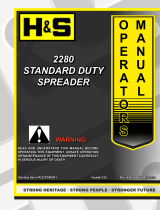 H&S S2280 User manual
H&S S2280 User manual
-
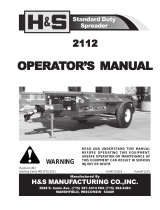 H&S S2112 Operating instructions
H&S S2112 Operating instructions
-
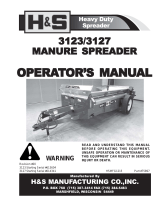 H&S S3127 Operating instructions
H&S S3127 Operating instructions
-
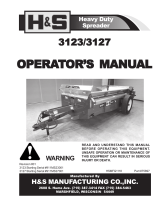 H&S S3127 Operating instructions
H&S S3127 Operating instructions
-
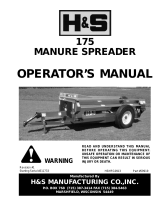 H&S MS175 Operating instructions
H&S MS175 Operating instructions
-
 H&S S3127 Operating instructions
H&S S3127 Operating instructions
-
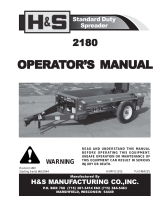 H&S S2180 Operating instructions
H&S S2180 Operating instructions
-
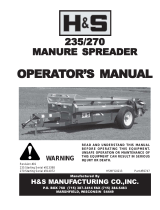 H&S MS235HE Operating instructions
H&S MS235HE Operating instructions
-
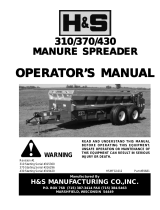 H&S MS310 Operating instructions
H&S MS310 Operating instructions
-
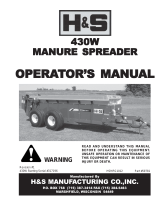 H&S 430 User manual
H&S 430 User manual
Other documents
-
Wallenstein MX Series Manure Spreader User manual
-
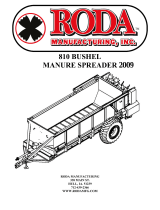 Roda 810 User manual
Roda 810 User manual
-
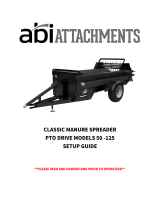 ABI Attachments 50-125 User guide
ABI Attachments 50-125 User guide
-
 Millcreek 8700P User manual
Millcreek 8700P User manual
-
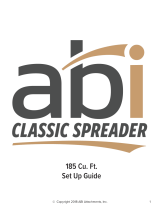 ABI Attachments abi Classic Spreader 185 Cu. Ft. User guide
ABI Attachments abi Classic Spreader 185 Cu. Ft. User guide
-
Meyer 8720 User manual
-
Meyer SXR/SXL Spreader Owner's manual
-
Meyer 8720/8865 Industrial Spreader Owner's manual
-
Meyer 5570 Industrial Series Super Spreader Owner's manual
-
Meyer 720/865 SXI Belt Drive Spreader Owner's manual











































